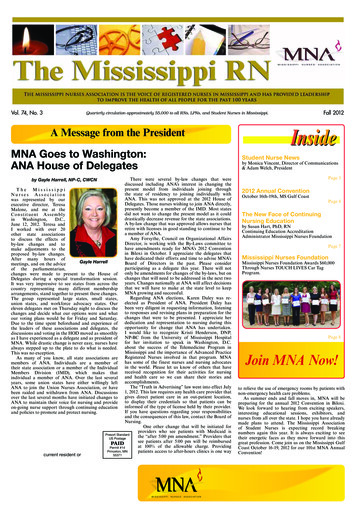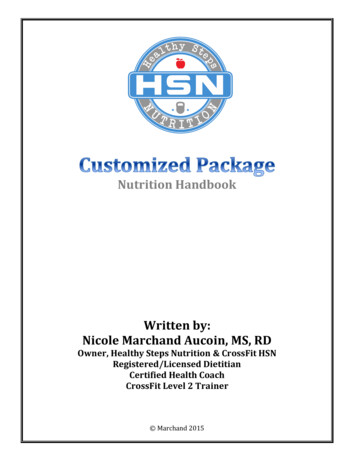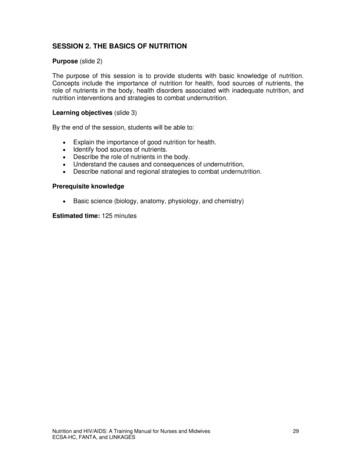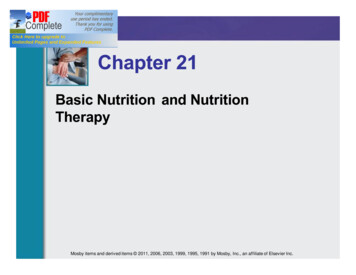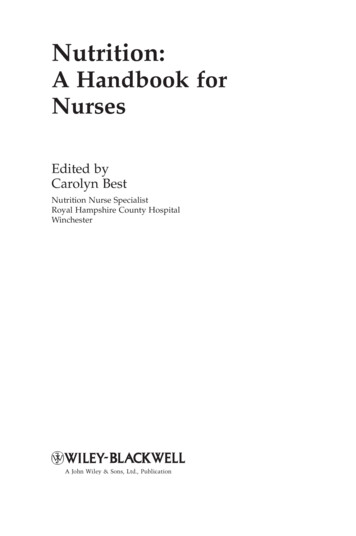
Transcription
Nutrition:A Handbook forNursesEdited byCarolyn BestNutrition Nurse SpecialistRoyal Hampshire County HospitalWinchesterA John Wiley & Sons, Ltd., Publication
Nutrition:A Handbook forNurses
Nutrition:A Handbook forNursesEdited byCarolyn BestNutrition Nurse SpecialistRoyal Hampshire County HospitalWinchesterA John Wiley & Sons, Ltd., Publication
This edition first published 2008 2008 John Wiley & SonsWiley-Blackwell is an imprint of John Wiley & Sons, formed by the merger of Wiley’sglobal Scientific, Technical and Medical business with Blackwell Publishing.Registered officeJohn Wiley & Sons Ltd, The Atrium, Southern Gate, Chichester, West Sussex, PO19 8SQ,United KingdomEditorial officeJohn Wiley & Sons Ltd, The Atrium, Southern Gate, Chichester, West Sussex, PO19 8SQ,United KingdomFor details of our global editorial offices, for customer services and for information abouthow to apply for permission to reuse the copyright material in this book please see ourwebsite at www.wiley.com/wiley-blackwell.The right of the author to be identified as the author of this work has been asserted inaccordance with the Copyright, Designs and Patents Act 1988.All rights reserved. No part of this publication may be reproduced, stored in a retrievalsystem, or transmitted, in any form or by any means, electronic, mechanical,photocopying, recording or otherwise, except as permitted by the UK Copyright, Designsand Patents Act 1988, without the prior permission of the publisher.Wiley also publishes its books in a variety of electronic formats. Some contentthat appears in print may not be available in electronic books.Designations used by companies to distinguish their products are often claimed astrademarks. All brand names and product names used in this book are trade names,service marks, trademarks or registered trademarks of their respective owners. Thepublisher is not associated with any product or vendor mentioned in this book. Thispublication is designed to provide accurate and authoritative information in regard to thesubject matter covered. It is sold on the understanding that the publisher is not engaged inrendering professional services. If professional advice or other expert assistance isrequired, the services of a competent professional should be sought.Library of Congress Cataloging-in-Publication DataNutrition : a handbook for nurses / edited by Carolyn Best.p. ; cm.Includes bibliographical references and index.ISBN 978-0-470-06131-2 (pbk. : alk. paper) 1. Diet therapy – Handbooks,manuals, etc. 2. Nutrition – Handbooks, manuals, etc. 3. Nursing – Handbooks,manuals, etc. I. Best, Carolyn.[DNLM: 1. Nutrition Therapy – nursing. WY 150 N9755 2008]RT87.N87N868 2008363.8 – dc222008013184A catalogue record for this book is available from the British Library.Set in 10 on 12 pt Palatino by SNP Best-set Typesetter Ltd., Hong KongPrinted in Singapore by Markono Print Media Pte Ltd12008
ContentsContributorsPrefaceIntroduction123National and European Initiatives to ImproveStandards of Nutritional CareCarolyn BestIntroductionNational and European initiatives 1990–2007ConclusionReferencesMalnutritionHarriet Gordon and Helen HitchingsIntroductionWhat is malnutrition?Signs and consequences of malnutritionSpecific vitamin and mineral deficienciesManagement of malnutritionNutrition supportRecognising and managing malnutrition in obesepatientsConclusionReferencesNutrition Screening and AssessmentHelen HitchingsIntroductionNutrition v
viContentsNutrition assessmentScreening toolsDocumentationWhen to refer to a dietitianConclusionReferencesFurther reading45The Nursing Role in Maintaining Patients’ OralNutritional IntakeCarolyn BestIntroductionIdentifying the problemsRegistered nurse responsibilities in patient nutritionThe responsibilities of the healthcare assistantRoles and responsibilities of other individuals involvedin patient nutritionThe patient in hospitalRecommendations to improve patient intakeSafety considerations when assisting a patient to eatHelping the dysphagic patient to eatEffects of dementia on oral nutritional intakeRed traysProtected mealtimesRecording food intakeUse of specialised equipmentEducating healthcare workers to assist patients withtheir mealsReferencesEnteral NutritionCarolyn Best, Helen Hitchings, Joanna Boult andHarriet GordonIntroductionOral nutrition supportOptions for enteral tube feeding: short-term feedingOptions for enteral tube feeding: long-term feedingEnteral tube feedsDrug administration through an enteral feeding tubeFlushing enteral feeding 467687071727474767778798181828698115120124125126
Contents67Parenteral NutritionCarolyn Best, Helen Hitchings, Joanna Boult andHarriet GordonIntroductionIndications of parenteral nutritionClinical assessment of the patient requiring parenteralnutritionRoutes for intravenous accessTypes of central venous catheterNon-central access optionsMulti-lumen vs single-lumen cathetersConfirming central venous catheter tip positionUsing a previously used central venous catheterAftercare of line and insertion siteDressing changesObservationsFlushing following insertionEstimating nutritional requirementsBiochemical and haematological assessmentPreparations availableNutritional content of parenteral nutritionAllergies to components of parenteral nutritionDrug therapy that may affect nutrition supportCare of parenteral nutrition before administrationMode of delivery: continuous or cyclical administrationAdministration of medication through a centralvenous catheterShould an in-line filter be used?Maintaining catheter patencyPatient monitoringComplications associated with the administration ofparenteral nutritionDiscontinuing parenteral nutritionRemoval of a central venous catheterThe role of non-medical prescribing in parenteralnutritionConclusionReferencesFurther readingRe-feeding SyndromeHelen Hitchings and Harriet 55160161161162162165167167
viii89ContentsThe process of starvationIncidence of re-feeding syndromeImpact on the patientSummary of electrolyte disturbancesReducing the risk of re-feeding syndromeWard checklist for re-feeding 80Ethics and Commitment to FeedCarolyn BestIntroductionBenefits vs burdenInformed consentDecision-making in the competent patientDecision-making in the non-competent patientBest interestsAdvanced directivesPower of attorneyPercutaneous endoscopic gastrostomy feeding inadvanced dementiaPersistent vegetative stateWithdrawing nutrition supportConclusionReferencesFurther reading183The Role of a Hospital Nutrition Support TeamCarolyn Best, Helen Hitchings, Joanna Boult andHarriet GordonIntroductionRoles within the teamIndividual roles within the core teamGetting started: developing the Nutrition Support TeamAgreeing the referral processDeveloping skills within the Nutrition Support TeamMaintaining momentumAgreeing standards for practiceProving the worth of the Nutrition Support TeamThe role of the Nutrition Steering 3215216216
Contents1011Transfer of Care from Hospital to CommunityCarolyn Best and Helen HitchingsIntroductionPlanning dischargeEducationTraining requiredEquipment required for dischargeThe review processPotential problemsConclusionReferencesFurther readingSupport group detailsCase StudiesHarriet Gordon, Carolyn Best, Helen Hitchings andJoanna BoultIntroductionEnteral nutritionCombined enteral/parenteral nutritionParenteral 9230230231231231243246253Glossary and Abbreviations255Index265
ContributorsCarolyn BestBSc (Hons), RGN, Dip HENutrition Nurse SpecialistHelen HitchingsBSc (Hons), RD, Dip ADPNutrition & Dietetic Services ManagerHarriet GordonMD, FRCPConsultant GastroenterologistJoanna BoultMPharm, DipClinPharm, MRPharmS (Gastroenterolgy)Specialist Pharmacistxi
PrefaceGood nutrition underpins good clinical care. Where a patient’s nutritional intake is impaired over a period of time, nutritional deficienciesoccur. The patient admitted to hospital may already be malnourishedor have lost the desire or ability to eat, because of illness. This maybe further compounded, following admission, by the need to placethe patient ‘nil by mouth’ in preparation for procedures or operations.Failure to identify these problems and address the issues appropriately will lead to the patient’s nutritional status being furthercompromised.Nurses are the one group of healthcare professionals who provide24-hour care for patients in a hospital setting and are therefore in anideal position to identify nutritional problems and instigate initialcare and onward referral. Unfortunately, nurses do not always recognise the important role they have to play in the patient’s nutritionalcare.This book aims to raise awareness and address some of the issuesthat nurses will encounter when caring for patients’ nutritionalneeds in a hospital setting. It will also highlight the benefits that ahospital-based Nutrition Support Team can offer by providing amultidisciplinary approach to nutrition.We write this book as an established, functioning Nutrition SupportTeam within a district general hospital that addresses patients’complex nutritional needs on a daily basis. We hope to educate butdo not profess to provide all the answers to those difficult ethicalissues or clinical decisions that may arise.We hope you will find this book informative and easy to read and,although aimed primarily at nurses, hope it will be a reference guidefor all clinical staff.Carolyn BestNutrition Nurse Specialistxiii
IntroductionThis book aims to provide a comprehensive look at all aspects ofnutrition, from roles and responsibilities to caring for a patient withspecific nutritional needs.The type and level of care required by patients will vary from oneclinical setting to another. However, each will require specialist knowledge not only in terms of practical skills but also in terms of theassessment, monitoring and evaluation of the care provided. Thisbook will present information that will enable the reader to updatetheir knowledge and skills, which will hopefully equip them with theability to offer a better standard of care to their patients. This book isstructured to follow key issues with summary points and clinical casestudies to be both an essential reference and educational tool.We have planned the book to guide the reader through variousstages of clinical nutrition, starting with Chapter 1 with a brief lookinto the national and European initiatives published since 1990 aimedat improving standards of nutritional care in primary and secondarycare environments and influencing our clinical practice.Chapter 2 looks at how malnutrition can develop, how to recognisethe signs and makes recommendations for treatment. It also givesdetails on the consequences of poor, or non-, treatment of the condition and will look at the increasing need to recognise and managemalnutrition in obese patients.Chapter 3 addresses the important issue of nutrition screening andidentifies the difference between nutrition screening and assessment.We also look at when it is appropriate to refer the patient to a dietitian.Chapter 4 concentrates on the important but often unrecognised rolethat nurses have to play in ensuring that the patient receives the oralnutrition appropriate to their needs and the barriers that prevent thishappening. We look at the initiatives that can assist in improvingxv
xviIntroductionnutrient intake and make some suggestions for the education ofnurses and carers.Using a step-by-step approach, Chapter 5 takes the reader throughthe four stages of enteral nutrition support: ensuring the patientreceives an appropriate oral diet, fortifying foods, nutritional supplements and enteral tube feeding. The section on enteral tube feedingprovides information to enable the reader to appropriately care forthe patient with an enteral feeding tube, looks at the issues arounddrug administration through feeding tubes, identifies potential complications and provides advice on how issues can be resolved. Chapter6 moves on to the administration of parenteral nutrition, includingclinical assessment of the patient, central line care, nutritional contentof parenteral nutrition and care of the bag before use. Finally, thischapter looks at the role of non-medical prescribing in parenteralnutrition.Chapter 7 looks at the process of starvation and the risk of refeeding syndrome when feeding is commenced, making recommendations to reduce the risks for staff at ward level.In Chapter 8, we look at the legal and ethical issues that may arisewhen consideration is given to commencing nutrition support, anaspect of care that is becoming frequently discussed in the nationalpress. We explore the decision-making process in the competent andincompetent patient, the use of advanced directives, feeding in dementia and persistent vegetative state and the difficulties that arise whenconsidering withdrawing nutrition support.Chapter 9 provides an insight into the setting-up of a hospitalNutrition Support Team and explores the benefits and difficulties thatmay be experienced by any district general hospital planning to establish such a team.In Chapter 10, we look at the issues that may arise when discharging a patient from hospital to home with nutrition support, includingthe level of education and equipment required to ensure a safe transfer of care, the review process that should be undertaken to keep thepatient stable at home and some of the potential problems that mayarise.In our final chapter, we present a number of case studies to demonstrate some of the issues we have had to face when consideringoptions for nutritional care.At the end of the book, the Glossary lists the various terms andacronyms used in the text, and in the field of nutrition.
Chapter 1National and European Initiatives toImprove Standards ofNutritional CareCarolyn BestIntroductionIn 1859, Florence Nightingale made the statement that ‘thousands ofpatients are annually starved in the midst of plenty’ (Tierney, 1996).Disturbingly, in the twenty-first century similar observations ofpatients in hospital are still being made.Despite the clear indication that poor nutrition in hospital is not anew problem, little importance was attached to this aspect of healthcare until the 1970s, when Butterworth (1974) in the United States ofAmerica discussed the issue of poor nutrition, and Bistrian et al.(1976) highlighted levels of poor nutrition of 44% or more. In 1977,Hill et al. examined surgical patients in Leeds, reporting that malnutrition and vitamin deficiency often went unrecognised anduntreated by hospital staff and that few patients had even had theirbody weight measured. In spite of these research findings, 17 yearslater McWhirter and Pennington (1994) revealed that 200 out of 500patients admitted to a hospital in Scotland were malnourished andthat 75% of those patients followed lost further weight during theirhospital stay.In response to the recognition of the effect of poor nutrition onhealth, a number of policies, guidelines and resolutions were published towards the end of the twentieth and into this century in anattempt to address the problem.To understand how these initiatives affect our daily workingpractice, and to set the scene for this book, it is important that wegain an insight into what each says. This chapter aims to give abrief outline of the aims of a number of UK and European initiatives to improve the nutritional care of patients. The list discussedis by no means exhaustive, so apologies for any we have missed.1
2Nutrition: A Handbook for NursesWhere a report concerned discusses wider issues in relation tohealthcare, we have highlighted those parts of it that refer tonutrition.National and European initiatives 1990–20071990Nutritional support in hospitals in the United Kingdom:National survey 1988 (Payne-James et al., 1990)Although the incidence of malnutrition in hospital patients had beenrecognised as a problem since the mid-1970s, until 1990 only twosurveys had been undertaken in the United Kingdom that looked atthe provision of nutrition support (Tredger et al., 1981; Green et al.,1987). Unfortunately, both of these studies only looked at nasogastrictube feeding.The 1988 survey (Payne-James et al., 1990) was undertaken to ascertain the level and type of nutrition support provided to the nutritionally compromised hospital patient in 206 districts in the UnitedKingdom. It looked at all the methods of nutrition support providedto patients. As dietitians were the only healthcare professionals solelyworking with patients with nutritional needs at the time, questionnaires were targeted at them. The survey reveals a wide variation inthe provision of nutrition support throughout the country.Its recommendations for the future of clinical nutrition supportinclude: Each district (hospital) should have a group of people with aninterest in clinical nutrition to monitor and advise on the careprovided.The development of a national multidisciplinary group to advise,educate and promote the appropriate use of nutrition support andto encourage research into the field. This led to the developmentof the British Association for Parenteral and Enteral Nutrition(BAPEN).1992A Positive Approach to Nutrition as Treatment (Lennard-Jones, 1992)This report was published to raise the awareness of healthcareprofessionals of the effects of poor nutrition and to improve the
National and European Initiatives to Improve Standards3treatment of clinical malnutrition in hospital and at home throughthe development of local and national standards. This was the firstdocument that set standards for nutrition in practice in the UnitedKingdom and stemmed from the results of the Nutritional support inhospitals in the United Kingdom: National survey 1988 (Payne-Jameset al., 1990).1996Standards and Guidelines for Nutritional Support of Patients inHospital (Sizer, 1996)This booklet, compiled by BAPEN, agreed national standards forthe organisation and provision of nutrition support for patients inhospital.The standards stipulate that there should be: a management policy within healthcare organisations stating thatall patients receive adequate and appropriate nutrition supporta functioning catering liaison group with representation fromcaterers, dietitians, nurses and doctorsthe development of a Nutrition Support Team to advise on allaspects of nutrition supportthe need to have organisation-wide policies in place for the provision of enteral and parenteral nutritionthe provision of a continuing education programme addressingissues surrounding general nutrition and techniques of nutritionsupport for all staff involved in the clinical care of patientsdetails on what care the patient can expectthat there is a robust audit process in place.1997Hungry in Hospital? (Community Health Councils, 1997)This briefing explores the issues around why some patients do noteat and drink enough when they are in hospital and who shouldbe responsible for ensuring that patients’ nutritional needs are met.It also makes recommendations to address the issues identified. Itis based upon the experiences of a number of community healthcouncils and the concerns relayed to them by families regarding thecare their elderly relatives received in hospital. Much of the criticism for patients’ poor food and fluid intake was aimed at nursingstaff.
4Nutrition: A Handbook for NursesEating Matters (Centre for Health Services Research, 1997)Following the criticism aimed at nurses in the Hungry in Hospital?report, the Department of Health commissioned an education packaimed at addressing nurses’ understanding of the importance ofnutrition and tackling practical issues to improve nutritionalintake.Eating Matters is the resource pack developed.Its aims were to: help hospital staff meet patients’ nutritional needs whilst they arein hospitaloffer practical solutions on how to audit and improve clinicalpracticeprovide a number of teaching aids and case studies.Its chapters include: an overview of nutritional issues relating to the care of the patientin hospitaleducating ward staffissues around swallowing and the presentation of foodfortifying foodsauditing dietary care.1998Ethical and Legal Aspects of Clinical Hydration and NutritionalSupport (Lennard-Jones, 1998)This report highlights the ethical issues that surround any decisionmade for patients requiring nutrition support and offers guidance onappropriate action.The report explores important issues, including: the impact of physical death and loss of personalitydefining the differences between withholding or withdrawinghydration or nutrition given through a feeding tubethe difference between an act and an omission to actthe rights of the competent patientprotecting the rights of, and decision-making for, incompetentpatientsdecision-making in infants, children and adolescentsthe right of the patient or family to demand fluid or nutrition viaa tube.
National and European Initiatives to Improve Standards51999Current Perspectives on Enteral Nutrition in Adults (McAtear, 1999)This document was released to provide up-to-date information oncurrent practice in enteral feeding with the aim of assisting the development of local policies and procedures.It addresses issues such as: why patients should be fed enterallywhich groups of patients should be fed enterallyhow a patient’s nutritional requirements should be estimatedroute and tube options for enteral feedingthe types of feed available for enteral feeding and when eachshould be usedwhat monitoring should be undertakenpossible complications that may arise and recommendations formanagement.Managing Nutrition in Hospital: A Recipe for Quality(Davis and Bristow, 1999)This report focuses on the key organisational and management issuesrelating to food and feeding in hospital, from ward level upwards.The findings confirm the need for clear definitions of roles and responsibilities together with closer coordination of food provision andnutritional care at all levels within hospital Trusts.Hospital Food as Treatment (Allison, 1999)This report looks at inadequacies in the provision of hospitalfood and makes recommendations on how these issues could beaddressed.It addresses: the consequences of malnutritioncommon reasons why people don’t eat in hospitalthe cost and prevalence of food wastagethe level of nutrient consumptionthe screening, assessment and monitoring of patientsimproving the distribution and service of mealsthe nutritional requirements of patientsstaffing, staff training and education.
6Nutrition: A Handbook for NursesThe report concludes that there is room for improvement in allaspects of care, from the nutrition screening of patients on admissionto the development of appropriate menus and methods of servingfood.2000Guidelines for Detection and Management of Malnutrition(British Association for Parenteral and Enteral Nutrition, 2000)These guidelines discuss the development of a new screening toolfor use in the detection and management of malnutrition inthe community – the MAG tool. It includes explanations on how touse the tool and makes recommendations on areas for futureaudit/research.Reducing Food Waste in the NHS (Department of Health, 2000a)This publication promotes good practice in NHS hospitals to minimise food wastage.It: considers who is responsible for controlling food wasteidentifies stages in the hospital food cyclemakes recommendations for best practice.It provides hospital managers and other professionals involved inthe provision of food within hospitals with a guide highlighting wherefood waste occurs and how to control it. It also provides a tool forhospital caterers that encourages a multidisciplinary approach tomonitoring and tackling food waste.NHS Plan (Department of Health, 2000b)The NHS Plan outlines the Department of Health vision of the futurehealth service: a service ‘designed around the patient’.In relation to nutrition and food service, the NHS Plan states thatby 2001 there would be a: 24-hour catering service available with a new NHS menunational franchise for NHS catering.It also states that:
National and European Initiatives to Improve Standards 7housekeepers will be present on half of all wards by 2004dietitians will advise and check on the nutritional values of hospital food as part of the Performance Assessment Frameworkthere will be a regular programme of unannounced inspectionsof the nutritional quality and presentation of hospital food.2001Essence of Care (Department of Health, 2001a)This document arose from a commitment made in Making a Difference:Strengthening the nursing, midwifery and health visiting contribution tohealth and healthcare (Department of Health, 1999) to explore the benefits of benchmarking to help improve the quality of fundamental andessential aspects of care. It was designed to support the measures toimprove quality set out in A First-Class Service (Department of Health,1998) and help practitioners to take a structured approach to sharingand comparing practice, to identify best practice and to develop actionplans to remedy poor practice.Eight standards were agreed upon, of which the Food and Nutrition standard was the third. The Food and Nutrition standard wasthen broken down into 10 factors, each of which was to be auditedand its performance measured:1.2.3.4.5.6.7.8.9.10.screening and assessment to identify patients’ nutritionalneedsplanning, implementation and evaluation of care assessmentsfor those patients who require a nutrition assessmenta conducive environment (acceptable sights, smells andsounds)assistance to eat and drinkobtaining foodfood providedfood availabilityfood presentationmonitoring of foodeating to promote healthNational Service Framework for Older People(Department of Health, 2001b)In relation to nutrition, this framework states that ‘nutritional riskscreening should take place to identify those with characteristics ofnutritional concern. For those at particular risk, a nutrition plan needs
8Nutrition: A Handbook for Nursesto be developed, appropriate food provided, food intake monitoredand action taken if nutritional needs are not being met.’Better Hospital Food Programme (NHS Estates, 2001)The Better Hospital Food programme was designed to raise the profileof the quality of food offered to patients in NHS hospitals in Englandand to make effective changes to hospital food services nationwide.It followed the recommendations made in the NHS Plan (Departmentof Health, 2000b).The Better Hospital Food programme’s initial aims were to: produce a comprehensive range of tasty, nutritious and interesting recipes that every NHS hospital could useredesign hospital printed menus to make them more accessibleand easier for the patient to understandintroduce a 24-hour catering service to ensure food was availablenight and dayensure hot food was available in hospitals at lunchtimes andearly-evening meals.As a result of the work undertaken during this project, a numberof initiatives were piloted and implemented, including: the National Dish Selector, containing over 300 recipes developedby a team of leading chefs for use in healthcare facilitiesthe Flexi Menu, aimed at providing patients with a greater choiceof mealsprotected mealtimesthe provision of food 24 hours a day using:䊊light-bite hot meals, with dishes such as cottage pie and codin parsley sauce䊊light refreshments provided through ward kitchens, such astea or coffee with biscuits, cake or fresh fruit䊊snack boxes, containing sandwiches or cheese and crackers,a piece of cake or a biscuit, fruit and a drink.Acute Hospital Portfolio: Review of National Findings – Catering(Audit Commission, 2001)This review records the national results of an investigation of hospitalcatering carried out by the Audit Commission as part of its AcuteHospital Portfolio. It is based on data collected during 1999/2000 and
National and European Initiatives to Improve Standards9involves the participation of most of the NHS hospitals in Englandand Wales.The main areas reviewed in this report are: how patients’ nutritional needs are identified and metthe quality of the catering service provided and the relationshipbetween quality and coststhe actual expenditure on catering and the variation in spendingbetween Truststhe management and control of coststhe potential savings available from reducing food waste onwards.In conclusion, the report states that:1.2.3.4.5.6.There is scope for many Trusts to improve the quality of theircatering service.Patients’ nutritional needs are not always identified or are notfulfilled, owing to limited menu choice, poor timeliness of mealsor lack of assistance provided to eat.More effective communication is required between the cateringdepartment and other staff to raise and then maintain the qualityof the service delivered to patients.Cost savings could be made through better pricing policies fornon-patient services, reducing the waste of unserved meals.Trusts need better information for decision-making and needeffective mechanisms for ensuring that funds set aside for improving patient services are spent in this area and not redirected intosubsidising non-patient services.Patient satisfaction must be closely monitored to ensure that atighter control of costs does not bring about a decline in servicequality.2002Improving Health in Wales: Nutrition and Catering Framework(Welsh Assembly Government, 2002)This document sets a number of standards that Trusts in Wales areexpected to meet, including that: All Trusts
Introduction 41 Nutrition screening 41 v. vi Contents Nutrition assessment 44 Screening tools 51 Documentation 53 When to refer to a dietitian 53 Conclusion 54 References 54 Further reading 55 . Introduction This book aims to provide a comprehensive look at all aspects of nutrition, from ro





